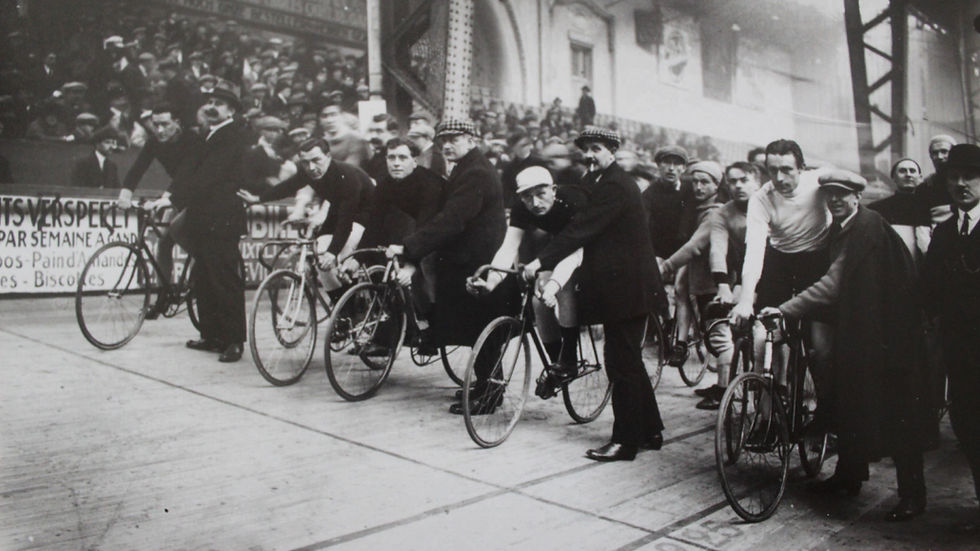
Omloop Het Nieuwsblad feels like a very long way away. Perhaps I have been conditioned by the covid-induced, enhanced autumn seasons of late, but the first glimpses of spring feel like they’re at the end of a 250 kilometer transition stage of Le Tour, and I, in my naivety, have attacked from the gun, in a forlorn attempt at getting there faster.
To aid me in the pursuit of spring, I have turned to the wacky world of track cycling - and its main event, The Six Days of Ghent, is just around the corner. I decided to see where the most peculiar of disciplines came from.
Madison Square Garden
The Six-day can trace its origins back to Islington, London, in 1878, beating out the first modern road races by some 20 years, and Le Tour de France by 25. Here, the racing scene developed, before jumping across the Atlantic to the United States, and with the move, experiencing a boom in popularity. The objective in these fledgeling years was simple; you had six days to ride as far as you were able to. Sleep was optional, doping very much encouraged. The riders’ health plummeted as fatigue consumed them, often sending them into fits of delusions and hallucinations.
The New York Times, acting as both the promoter and reporter of an event in 1897, summed up the Six-day succinctly:
It is not sport. It is brutality.
The attrition rate of the Six-day was becoming unsustainable. Such was the toll these events were having on their competitors, it is reported that riders had “fallen asleep on their bikes and never woken up.” The sport had to change, and it would be forced to by the state of New York, which mandated no athlete could ride for more than 12 hours in a day. It was this change that gave birth to the ‘Madison’, an event that survives to this day (the name arising from Madison Square Garden, the famous events arena that was once a hub for Six-day racing).
The sport became an institution in the Jazz Age of American culture; its popularity meant this spectacle of endurance found its way back over the Atlantic, where we find ourselves in Ghent over 100 years later.

G-forces
First held in 1922, Zesdaagse Vlaanderen-Gent has seen 80 editions in its 100 years of existence, with road stars such as Rik Van Looy, Tommy Simpson, and more recently, Bradley Wiggins, all trying their hand at conquering the sharp, short Kuipke velodrome in Ghent's Citadelpark.
Whilst the first couple of editions were held outside on a concrete velodrome, the Ghent Six-day is now synonymous with the venue in which it is held. The Kuipke (roughly translating to ‘little tub’ or ‘little bowl’) is short - at just 167 meters - and the banking is fiercely steep to compensate, maxing out at 52 degrees. Mark Cavendish, winner in 2016 with Bradley Wiggins, highlighted the peculiarity of the track:
Physically, just the G-forces are more and it really does take its toll on the body. Every banking builds your legs up with lactic acid.
But it is the peculiarity that makes this event such a spectacle in the world of cycling. Holding over 3000 people, with beer flowing and music pumping until one o’clock in the morning, the Six-day is as much a party as a race. A party where you can watch some of the greats, both from the boards of the velodrome and the road.

Swan-song
That brings us onto this year's edition. Hometown hero and seven time winner, Iljo Keisse, lines up one more time before retirement with his partner Jasper De Buyst. The pair aren’t confident of a fairytale send off, with Keisse suggesting the young British duo of Ethan Hayter and Fred Wright are, “if you look at individual qualities, the strongest duo”. But the boards of Kuipke are unrelenting, and Wright in particular must be feeling the effects of both Le Tour and La Vuelta in his legs.
Elsewhere, the likes of Robbe Ghys and Lindsay de Vylder stand out, with the former a two time winner and the latter coming into some great form at the recent track world championships. Yoeri Havik, world points race champion, and his teammate Fabio Van den Bossche also look strong.
But for the 3000 spectators and 24 riders who’ll visit Zesdaagse Vlaanderen-Gent, the race is about more than just winning. It’s the continuation of a 140 year old tradition, one that honours the best riders in the world, who dedicate their lives to pushing themselves beyond their limits. It’s a celebration of all that is weird and wacky in the sport of cycling, in its cultural homeland. For Keisse, this swan-song is the perfect goodbye, he goes there “with the intention of having fun in the meantime… That place has dominated the past twenty years of my life.” Fans will be screaming one last time 'Iljooooo' during Ghent Six Days this week. Prepare yourself for some goosebumps.
(Pictures: © Lotto Zesdaagse Vlaanderen - Gent)
Comments